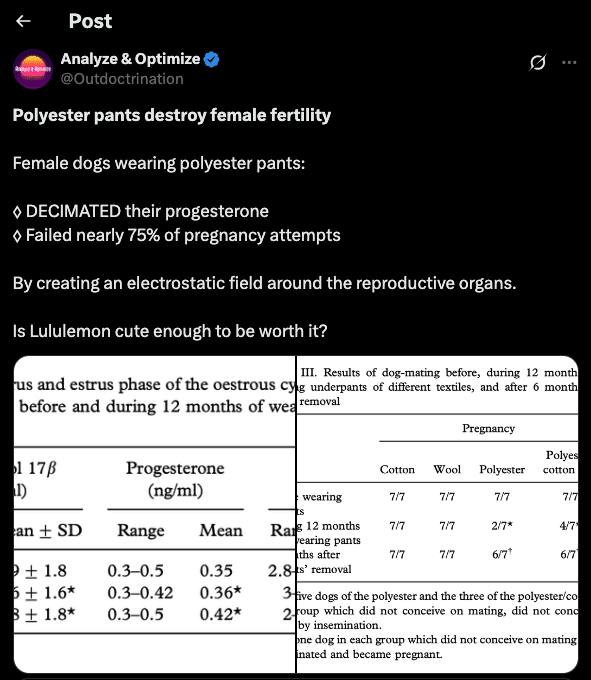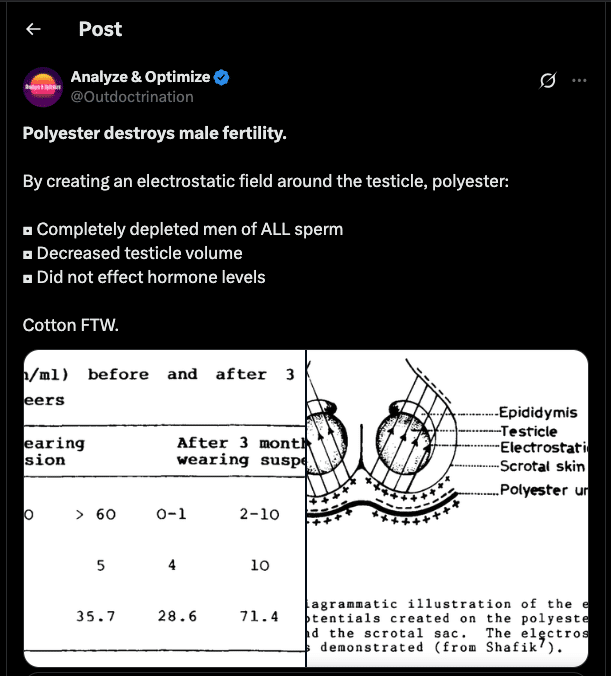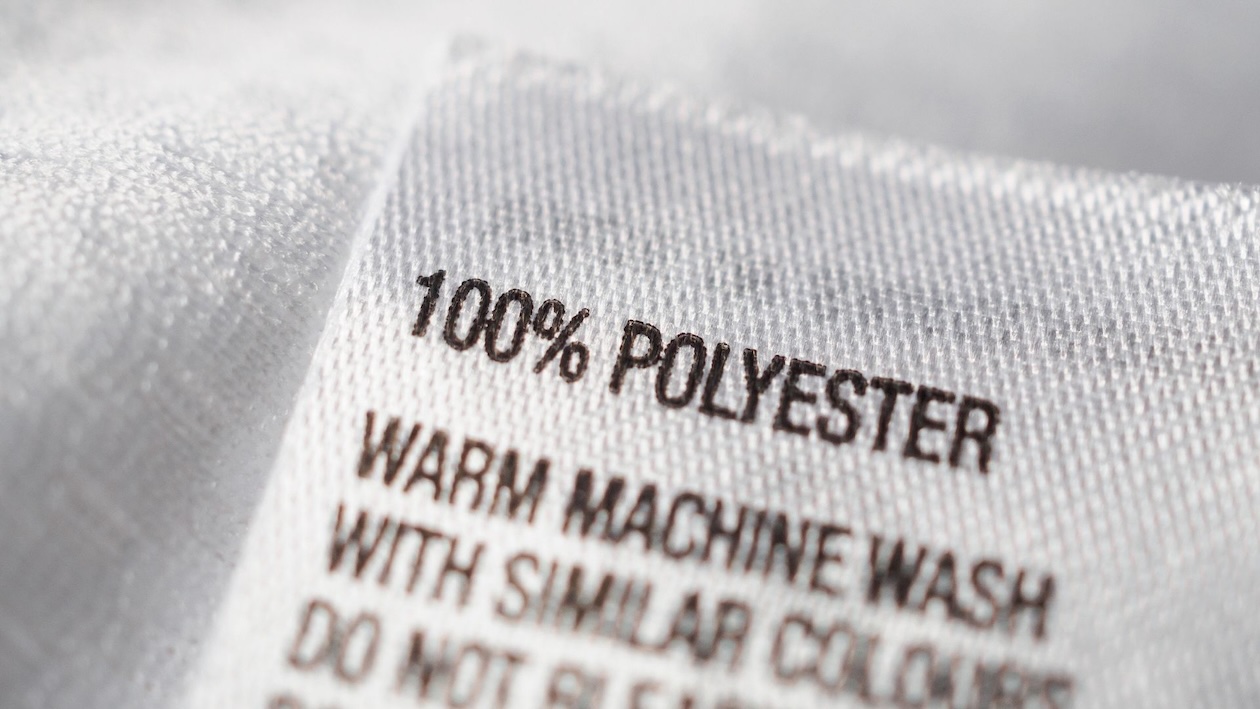This X post really threw me for a loop …


In an era of declining fertility and increasing chronic illness, few of us pause to consider that the clothes we wear every day could be silently contributing to the problem. But what if one of the culprits behind these health challenges was hanging in your closet—or worse, touching your most sensitive skin?
Welcome to the dark side of polyester and synthetic fabrics.
Polyester: The Oil-Derived Fabric in Your Wardrobe
Take a moment to check the labels on your clothing. Chances are, many of them list polyester, nylon, rayon, or acrylic—all synthetic materials made through chemical processes. Shockingly, even underwear and workout gear are often crafted from these fibers, placing petroleum-derived materials directly against your skin.
Polyester, in particular, was patented in 1941 and quickly became a darling of the fast fashion industry. Cheap, durable, and wrinkle-resistant, it offered everything a mass-market brand needed. But like many innovations tied to Big Oil, its convenience comes with hidden costs.
How Polyester Harms Your Health
- Disrupts Cellular Function: Polyester lowers the electrostatic potential of your cells, making it harder for them to function optimally. This subtle interference can throw off your body’s internal harmony.
- Releases Microplastics: Every time you wash a polyester garment, it sheds microfibers—tiny plastic particles that can be inhaled, absorbed through skin, or enter the food chain through water systems.
- Leaches Chemicals: Polyester clothing often contains dozens of chemical residues from dyes, finishing agents, and flame retardants—all of which can be absorbed through your skin.
This trifecta of toxic exposure may contribute to endocrine disruption, fertility issues, and immune system overload. When viewed through the lens of longevity and holistic health, polyester is a clear red flag.
Health Hack: Natural Fabrics Over Synthetics
The solution is both simple and powerful: ditch polyester and synthetic blends in favor of natural, breathable, and non-toxic materials.
Recommended fabrics:
- Organic cotton
- Linen
- Wool
- Silk
- Cashmere
- Bamboo
- Hemp
These fibers are biodegradable, free from synthetic chemical processing, and more aligned with how our bodies are designed to interact with the environment.
“It always amazes me that humans think we can outsmart nature. God already created the textiles we need to thrive. Let’s just stick with those.”
How to Detox Your Closet Without Going Broke
Upgrading your wardrobe can be overwhelming, but it doesn’t have to be all or nothing. Follow this gradual, prioritized approach to make the transition manageable and budget-friendly.
1. Start With the Essentials: Underwear
Your most sensitive body parts should never be in contact with synthetic fibers.
- For men: Look for cotton boxers or briefs from brands like NADS or OPOK
- For women: Choose cotton or silk bras and underwear. A quick online search will turn up trusted brands.
Pro tip: Watch out for “cotton blends”—you want 100% organic cotton for maximum benefit.
2. Upgrade Your Daily Basics
Focus next on the items you wear most frequently:
- Sweatpants
- T-shirts
- Sweatshirts
- Lounge clothes
Reliable brands for these staples include:
- Pristine Tee
- Cacio Pepe
- Mate the Label
- Quince
These pieces often act as your second skin throughout the day—replacing them has an outsized impact on exposure reduction.
3. Revamp Work and Going-Out Attire
Once your basics are upgraded, shift your focus to less frequently worn items like business casual wear and evening outfits. Great brands for elevated style include:
- Taylor Stitch
- Faherty
- Todd Snyder
- Buck Mason
- Huckberry
- Suit Supply
These companies emphasize craftsmanship, sustainability, and natural fibers.
4. Tackle the Final Frontier: Workout Clothes
The hardest switch for many people is activewear, which is notoriously dominated by polyester and nylon blends. Be cautious of terms like:
- “Moisture-wicking”
- “Static-resistant”
- “Stain-resistant”
- “Wrinkle-free”
These often signal the presence of chemical coatings.
Better options for athleticwear include:
- PACT
- Allwear
- Mate the Label
- Quince
Bonus tip: If you can’t yet replace your entire workout wardrobe, start by wearing organic cotton underwear beneath your gear to limit direct skin exposure.
The Bigger Picture: Convenience Comes at a Cost
Polyester may be affordable, but the long-term effects on your health, fertility, and environment are too significant to ignore. By choosing natural materials, you not only protect your skin, hormones, and organs, but also support a more sustainable fashion system.
This is about more than style—it’s about reclaiming your health through smarter, ancestral living.
Join Our Skool Community
Want a complete list of non-toxic lifestyle essentials? From clothing to cookware to clean beauty, we’re compiling a Masterlist of Health Essentials for our members inside the Skool community.
Join now to lock in free access before our membership model launches. Early adopters will receive exclusive resources and bonus content.

Leave a Reply
You must be logged in to post a comment.